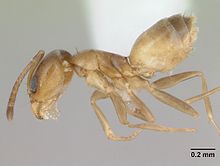
Autothysis or suicidal altruism is the process where an animal destroys itself via an internal rupturing or explosion of an organ which ruptures the skin. The term was proposed by Ulrich Maschwitz and Eleonore Maschwitz in 1974 to describe the defensive mechanism of Colobopsis saundersi, a species of ant. It is caused by a contraction of muscles around a large gland that leads to the breaking of the gland wall. Some termites release a sticky secretion by rupturing a gland near the skin of their neck, producing a tar effect in defense against ants.

Dolichoderinae is a subfamily of ants, which includes species such as the Argentine ant, the erratic ant, the odorous house ant, and the cone ant. The subfamily presents a great diversity of species throughout the world, distributed in different biogeographic regions, from the Palearctic, Nearctic, Afrotropical region and Malaysia, to the Middle East, Australian, and Neotropical regions.

Amyrmex golbachi is a rare Neotropical species of ant and the only known species in the genus Amyrmex. It is currently only known from males from the Amazon basin of Brazil and from northern Argentina.

Forelius damiani is a species of ant in the genus Forelius. It was discovered and described by Guerrero, R. J. & Fernandez, F. in 2008.
Animal suicide refers to any kind of self-destructive behavior displayed by various species of animals, resulting in their death. Although contradicting the natural progression of life and an animal's evolutionary instinct for survival, some situations may lead to an animal inducing their own death. Animal suicide in the defense of the group could be instantaneous or altruistic self-removal once an animal becomes diseased. There are anecdotal reports of grieving pets displaying such behaviour after the death of their owner, or monogamous animals refusing to feed after the death of their mate.
Forelius bahianus is a species of ant in the genus Forelius. Described by Cuezzo in 2000, the species is endemic to Brazil.

Forelius brasiliensis is a species of ant in the genus Forelius. Described by Forel in 198 the species is endemic to South America.
Forelius breviscapus is a species of ant in the genus Forelius. Described by Forel in 1914, the species is endemic to Argentina.
Forelius chalybaeus is a species of ant in the genus Forelius. Described by Emery in 1906, the species is endemic to Argentina.
Forelius grandis is a species of ant in the genus Forelius. Described by Forel in 1912, the species is endemic to Argentina.
Forelius keiferi is a species of ant in the genus Forelius. Described by William Morton Wheeler in 1934, the species is endemic to Mexico.
Forelius lilloi is a species of ant in the genus Forelius. Described by Cuezzo in 2000, the species is endemic to Argentina.
Forelius macrops is a species of ant in the genus Forelius. Described by Kusnezov in 195, the species is endemic to Argentina.
Forelius maranhaoensis is a species of ant in the genus Forelius. Described by Cuezzo in 2000, the species is endemic to Brazil.

Forelius mccooki is a species of ant in the genus Forelius. Described by McCook in 1880, the species is endemic to the United States and Mexico, where they nest in soil surrounded by a typically small mound, and also nests under stones.

Forelius nigriventris is a species of ant in the genus Forelius. Described by Forel in 1912, the species is endemic to South America.

Forelius pruinosus is a species of ant in the genus Forelius. Described by Roger in 1863, the species is endemic to North America.
Forelius rubriceps is a species of ant in the genus Forelius. Described by Gallardo in 1916, the species is endemic to Argentina.
Forelius rufus is a species of ant in the genus Forelius. Described by Gallardo in 1916, the species is endemic to Argentina and Bolivia.










